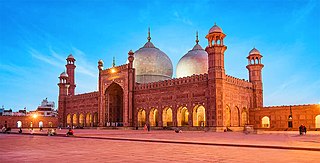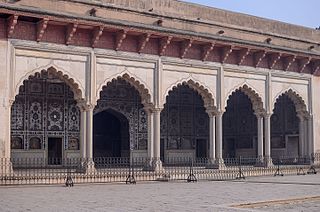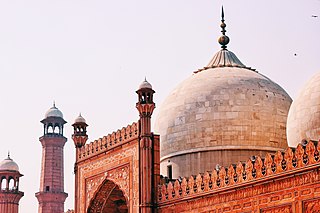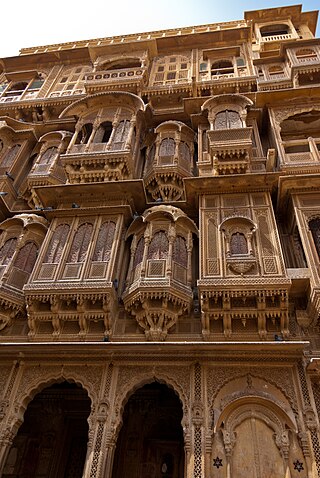Related Research Articles

Lahore is the capital and largest city of the Pakistani province of Punjab. It is the second largest city in Pakistan, after Karachi, and 26th largest in the world, with a population of over 14 million. Located in central-eastern Punjab, along the River Ravi, it is the largest Punjabi-speaking city in the world. Lahore is one of Pakistan's major industrial, educational and economic hubs. It has been the historic capital and cultural center of the wider Punjab region, and is one of Pakistan's most socially liberal, progressive, and cosmopolitan cities.

Bahawalpur is a city in Punjab, Pakistan. It is the 13th largest city of Pakistan and 8th most populous city of Punjab. Bahawalpur is the capital of Bahawalpur Division.

The Lahore Fort is a citadel in the walled interior of Lahore in Punjab, Pakistan. The fortress is located at the northern end of the Walled City of Lahore and spreads over an area greater than 20 hectares. It contains 21 notable monuments, some of which date to the era of Emperor Akbar. The Lahore Fort is notable for having been almost entirely rebuilt in the 17th century, when the Mughal Empire was at the height of its splendor and opulence.

The Walled City of Lahore, also known as the Old City, forms the historic core of the city of Lahore in Punjab, Pakistan. The city was established around 1000 CE in the western half of the Walled City, which was fortified by a mud wall during the medieval era. It has been the primary cultural centre of the Punjab region since the late-medieval era.

The Sheesh Mahal is a palace located within the Shah Burj block in northern-western corner of Lahore Fort. It was constructed under the reign of Mughal Emperor Shah Jahan in 1631–32, with some additions later under Sikh Maharaja Ranjit Singh. The ornate white marble pavilion is inlaid with pietra dura and complex mirror-work of the finest quality. The hall was reserved for personal use by the imperial family and close aides. It is among the 21 monuments that were built by successive Mughal emperors inside Lahore Fort, and forms the "jewel in the Fort’s crown." As part of the larger Lahore Fort Complex, it has been inscribed as a UNESCO World Heritage Site since 1981.

The Shalamar Gardens or Shalimar Gardens are a Mughal garden complex besides Baghbanpura, located in Lahore, Punjab, Pakistan. The gardens date from the period when the Mughal Empire was at its artistic and aesthetic zenith, and are now one of Pakistan's most popular tourist destinations.

The Architecture of Lahore reflects the history of Lahore and is remarkable for its variety and uniqueness. There are buildings left from the centuries of rule of the Mughal Empire, the Sikh Empire, as well as from the era of the British Raj, whose style is a mixture of Victorian and Islamic architecture often referred to as Indo-Saracenic. In addition, there are newer buildings which are very modern in their design. Unlike the emphasis on functional architecture in the west, much of Lahore's architecture has always been about making a statement as much as anything else.

Rohtas Fort is a 16th-century citadel located near the city of Dina in Jhelum district of the Punjab, Pakistan. Todar Mal, the minister of the Sur king Sher Shah Suri, supervised the construction of the fort which is now one of the largest and most formidable in Punjab.

A haveli is a traditional townhouse, mansion, or manor house, in the Indian subcontinent, usually one with historical and architectural significance, and located in a town or city. The word haveli is derived from Arabic hawali, meaning "partition" or "private space", popularised under the Mughal Empire, and was devoid of any architectural affiliations. Later, the word haveli came to be used as a generic term for various styles of regional mansions, manor houses, and townhouses found in the Indian subcontinent.

Old Delhi is an area in the Central Delhi district of Delhi, India. It was founded as a walled city and officially named Shahjahanabad in 1648, when Shah Jahan decided to shift the Mughal capital from Agra. The construction of the city was completed in 1648, and it remained the capital of Mughal India until its fall in 1857, when the British Empire took over as paramount power in the Indian subcontinent.

Taxali Gate was one of 13 historic gates of the Walled City of Lahore, Pakistan.
Pakistani architecture is intertwined with the architecture of the broader Indian subcontinent. The major architectural styles popular in the past were Temple, Indo-Islamic, Mughal and Indo-Saracenic architecture, all of which have many regional varieties. With the beginning of the Indus civilization around the middle of the 3rd millennium BC, for the first time in the area which encompasses today's Pakistan an advanced urban culture developed with large structural facilities, some of which survive to this day. This was followed by the Gandhara style of Buddhist architecture that borrowed elements from Ancient Greece. These remnants are visible in the Gandhara capital of Taxila.

The culture of Lahore refers to the cultural traditions and customs from Lahore, which form a central part of the Punjabi culture, and is a manifestation of the lifestyle, history, festivals, literature, music, language, politics, cuisine and socio-economic conditions of its people.
Mian Yousuf Salahuddin, commonly known as Yousaf Salli, is a Pakistani socialite, philanthropist, and ex-politician from Lahore.

Naukot Fort, built by Mir Karam Ali Khan Talpur in 1814, is a historic fortification located in Mithi Taluqa, Tharparkar District, Sindh. Often referred to as the "Gateway to the Thar Desert" due to its strategic position, the fort was constructed to defend the region against Rajput incursions.

Gurdwara Dera Sahib is a gurudwara in Lahore, Pakistan, which commemorates the spot where the 5th guru of Sikhism, Guru Arjan Dev, was martyred in 1606.

The Shrine of Mian Mir is a 17th-century shrine located in Lahore, Pakistan, that is dedicated to the Sufi mystic Mian Mir. The shrine is one of the most celebrated in Lahore, and has historically been revered by both Muslims and Sikhs.

The Haveli of Nau Nihal Singh, officially known as Government Victoria Girls' High School, is a haveli that houses a government school located in Lahore, Punjab, Pakistan. Dating from the Sikh era of the mid-19th century, the haveli is considered to be one of the finest examples of Sikh architecture in Lahore, and is the only Sikh-era haveli that preserves its original ornamentation and architecture.
Maharani Gulbahar Begum was a wife of Maharaja Ranjit Singh of the Sikh Empire.
References
- ↑ "The old world charms of Mian Salli". thefridaytimes.
- ↑ "Walled City Lahore - Havelis Of Lahore". walledcitylahore.gop.pk. Archived from the original on 29 April 2021. Retrieved 23 December 2024.
- ↑ "Gems of Lahore — The Havelis". pakistantoday.com.pk.
- ↑ "Flashback: From guns to roses". dawn.com.
- ↑ "Where the music never stops…". The News.
- ↑ "The corner: Ali Shah". tribune.com.pk.
- ↑ "Inside the Walled City of Lahore". insidelahore.com. Archived from the original on 9 September 2021. Retrieved 3 May 2018.
- ↑ "Yusuf Salahuddin: Guardian of Cultural Heritage". youlinmagazine.
- ↑ Fareeha Rafique (October 2012). "Interview: Mian Yusuf Salahuddin". Newsline magazine. Archived from the original on 27 June 2018. Retrieved 23 December 2024.